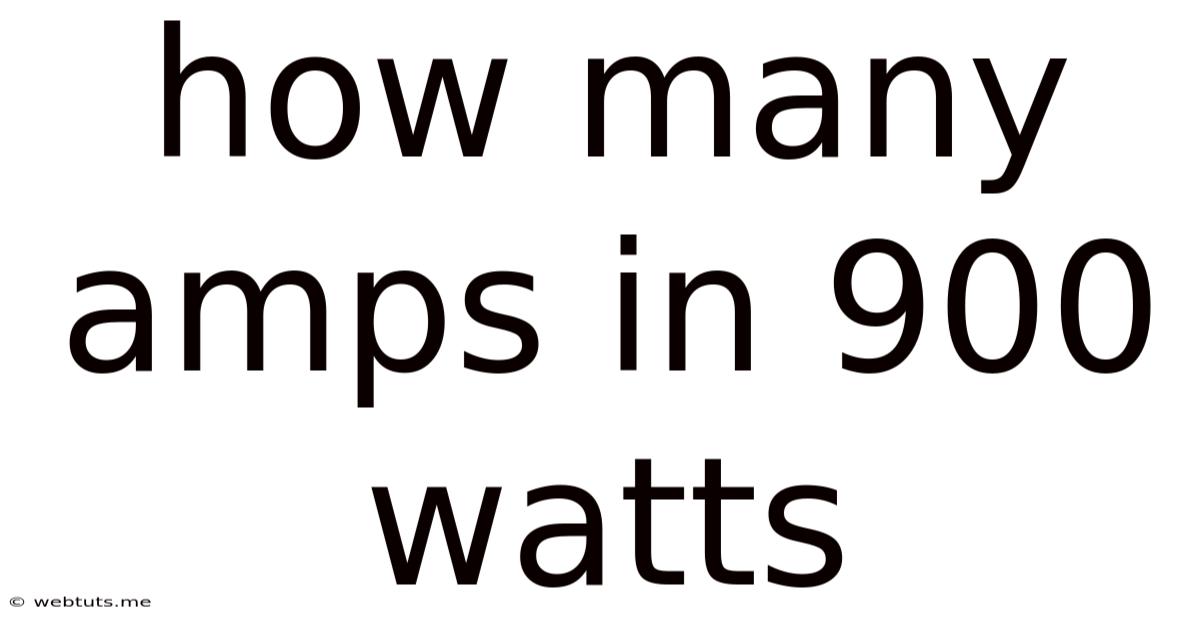How Many Amps In 900 Watts
Webtuts
May 12, 2025 · 4 min read

Table of Contents
How Many Amps in 900 Watts? Understanding Power, Current, and Voltage
Determining the amperage (amps) from wattage (watts) requires knowing the voltage (volts). This seemingly simple calculation is crucial for electrical safety and ensuring your appliances operate correctly. This article will thoroughly explain the relationship between watts, amps, and volts, providing a comprehensive understanding of how to calculate amperage, highlighting safety precautions, and exploring various scenarios where this knowledge is vital.
The Fundamental Relationship: Watts, Amps, and Volts
The power (measured in watts) consumed by an electrical device is directly related to the voltage (measured in volts) and the current (measured in amps) flowing through it. This relationship is defined by the following formula:
Power (Watts) = Voltage (Volts) x Current (Amps)
Or, more concisely:
P = V x I
Where:
- P represents power in watts
- V represents voltage in volts
- I represents current in amps
To find the amperage, we rearrange the formula:
I = P / V
This means that to determine the number of amps in 900 watts, we must know the voltage.
Calculating Amps for Different Voltages
The voltage varies depending on your location and the type of electrical system. Common voltages include 120V (standard in North America) and 230V (common in Europe and many other parts of the world). Let's calculate the amperage for 900 watts at these common voltages:
120V System
Using the formula:
I = P / V = 900 watts / 120 volts = 7.5 amps
Therefore, a 900-watt appliance operating on a 120V system will draw approximately 7.5 amps.
230V System
Using the formula:
I = P / V = 900 watts / 230 volts = 3.91 amps
Therefore, the same 900-watt appliance operating on a 230V system will draw approximately 3.91 amps.
This demonstrates the significant impact voltage has on amperage. A higher voltage results in a lower amperage for the same wattage.
Practical Applications and Examples
Understanding the relationship between watts, amps, and volts is crucial in various situations:
Choosing Appropriate Wiring and Circuit Breakers
When installing appliances or electrical equipment, it is essential to ensure that the wiring and circuit breakers are rated for the expected amperage. Using undersized wiring or circuit breakers can lead to overheating, fire hazards, and potential damage to equipment. Always check the appliance's specifications for its power requirements (watts) and ensure your wiring and circuit breaker are adequately sized to handle the resulting amperage.
Understanding Appliance Power Consumption
Knowing the amperage draw of your appliances helps you understand their power consumption and manage your electricity costs. High-amperage appliances consume more power and will contribute significantly to your electricity bill. This information is crucial for budgeting and energy efficiency improvements.
Identifying Potential Overloads
Overloading circuits is a significant safety hazard. Understanding the amperage draw of individual appliances allows you to prevent overloading circuits by avoiding the simultaneous operation of too many high-amperage devices on the same circuit. This proactive approach reduces the risk of overheating and potential fires.
Powering Devices in Different Locations
When traveling internationally or using appliances in areas with different voltage standards, it is crucial to understand the amperage implications. Using a device designed for a 120V system on a 230V system (or vice-versa) without proper voltage conversion can damage the appliance and pose a safety risk.
Working with Generators
Generators have power output limits measured in watts and often have current limitations in amps. Knowing the amperage requirements of your devices is vital to ensure you don't overload your generator, leading to potential damage or malfunction.
Safety Precautions
Working with electricity can be dangerous. Always prioritize safety when dealing with electrical calculations and installations:
- Consult a qualified electrician: For any complex electrical work, it’s always best to consult a qualified electrician. They have the expertise and knowledge to ensure safe and compliant installations.
- Never overload circuits: Ensure the total amperage draw of all devices connected to a single circuit does not exceed the circuit's capacity.
- Use appropriate tools and equipment: When working with electricity, always use properly insulated tools and follow safety guidelines.
- Understand your local electrical codes: Adhere to all local electrical codes and regulations when working with electrical systems.
- Turn off power before working: Always turn off the power supply before working on any electrical wiring or equipment.
Beyond the Basics: Power Factor
In AC circuits, the power factor represents the ratio of real power (watts) to apparent power (volt-amperes, VA). A power factor less than 1 means that the current is not perfectly in phase with the voltage, which can happen with inductive or capacitive loads like motors. In these cases, the simple formula P=V*I doesn't entirely represent the situation. The actual amperage drawn might be higher than calculated using only the wattage. For purely resistive loads (like incandescent bulbs), the power factor is 1, and the calculation is accurate.
Conclusion: Understanding Amps is Key
Understanding the relationship between watts, amps, and volts is crucial for anyone working with electrical systems or using electrical appliances. The simple formula, P = V x I, allows for quick calculations to determine amperage. However, always remember to consider safety precautions and consult professionals for complex tasks. Knowing the amperage draw of your devices is essential for safety, cost management, and ensuring the proper functioning of your electrical systems. Accurate calculations help prevent overloading, avoid damaging equipment, and ensure a safe electrical environment.
Latest Posts
Related Post
Thank you for visiting our website which covers about How Many Amps In 900 Watts . We hope the information provided has been useful to you. Feel free to contact us if you have any questions or need further assistance. See you next time and don't miss to bookmark.